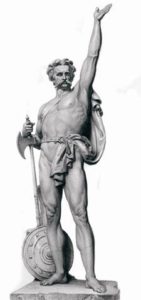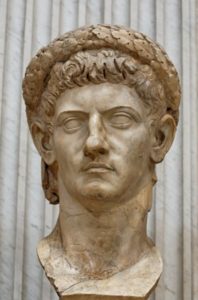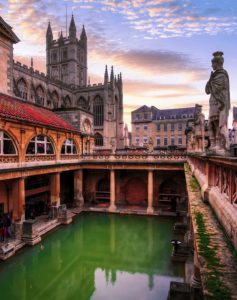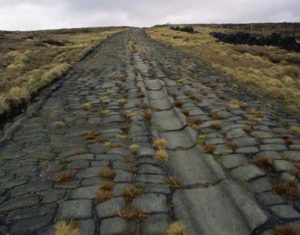Below is a detailed article about Roman Britain which is the time the Romans invaded Great Britain. It is also known as the Roman era in England.
Timeline of Roman Britain with brief history
Contents
55-53 BC, The Roman occupation of Britain begins with the first and second invasion of Julius Caesar
43 AD, Claudius orders the conquest of Britain; Aulus Plautius becomes the first Roman governor
50 AD, Foundation of current day London (Londinium)
55 AD, the Roman general Quintus Petillius Cerialis leads an expedition into what is now Wales and defeats the Celtic tribes there
61 AD, the Romans conquer southern England after the revolt of Boudicca and establish the province of Britannia
63 AD Joseph of Arimathea is dispatched to Britain to convert the people to Christianity.
77 AD, The Romans defeat the last of the resistant tribes in the North marking all of Britain Roman.
79 AD, Julius Agricola. Roman general, leads a series of campaigns against the Caledonians (the Scottish tribes)
122 AD, the construction of Hadrian’s Wall begins
209 AD, St Alban becomes the 1st English Christian martyr
306 AD, Constantine the Great declared Roman Emperor at York
312 AD, Emperor Constantine converts to Christianity and made Christianity legal throughout the Roman Empire.
410 AD, The Romans withdrew from Britain. Then it was invaded by different people, including the Anglo-Saxons, the Vikings, and the Normans
Tribal leaders during Roman conquest of britain
Roman constructions in England
Fiction books about Roman Britain
Roman England Money / Currencey
Horrible histories movie – Its plot and cast
Information about Roman Forts and Churches
History of Roman Britain Inventions
Information about the famous Roman Hadrian wall
Primary sources of information about Roman Britain
Roman Britain Timeline
The Romans had their hold over England for 400 years starting from the expedition taken over by Julius Caeser, a Roman dictator, politician, and military general.

55 BC
In this year, Julius Caeser made an attempt to invade England with a large force of around 10000 soldiers. They arrived at the coast of England to a place called ‘Deal’ where they were defeated by English warriors. Julius Caeser called for more army to come from France that could not arrive on the coast of England due to a storm. Therefore, he called off the expedition.
54 BC
In the following year, he came back stronger with a force of 27000 Roman soldiers. They were on infantry as well as cavalry. They crossed the coast of Deal and went further toward River Thames. Here, they were in face to face with a large English army. There was a large battle where the Romans defeated the English as some of the tribes and leaders surrendered to Julius Caeser. One of the prominent leaders was Cassivellaunus, a historical British tribal chief, who tried his best to keep the Romans away but eventually had to surrender. This happened because the Roman army was too large in number and stronger than the British men.
However, Julius Caeser had to go back to France and then Rome to solve issues that needed his supervision there.
54 BC to 44 AD
Between these years, due to the attempted invasions of Julius Caeser trade links started to develop between Rome and England. The Romans began to have a larger impact on English territories. In the year 43 AD, the Roman emperor orders 4 different troops to invade Britain. In this expedition, the Romans capture Essex and Colchester along with the Catuvellauni tribe.

In 44 AD, the Maiden Castle, a hill fort in Dorchester is captured by the Romans.
43 AD to 47 AD
Between these years, the Romans moved toward South Britain and declared the whole of South Britain as a part of the Roman Empire.
47 AD to 50 AD
The city of London was founded at this time by the Romans and called ‘Londonium’. They built a bridge across River Thames and connected different parts of South Britain to this area. All main operations took place at this place. During this time, they also founded a small colony of retired officers in the county of Colchester. Before London, Colchester was the capital of this newfound empire.
51 AD
The tribe of Catuvellauni had another British commando – Caratacus who led the conquest against the Roman empire in this period. He took with him two more tribes and marched ahead to fight the Roman invasion. However, he and his army were defeated by the Romans. He sought shelter from the Brigantes tribe in England. However, he was betrayed by their queen who sold him out to the Romans. The Romans caught hold of him and family and deported them all to Rome. They were prisoners there who were to be executed. However, King Claudius had mercy on him and let him live the rest of his life in Italy.

60 – 61 AD
The Romans went on to capture Wales but they were stopped by the massive Iceni tribe revolt. Their king was Prasatugus who died in 60 AD. He had signed a peace treaty with the Romans. After his death, his wife Boudicca decided to continue the peace in the kingdom by holding the treaty valid even after her husband’s death. However, the Romans were ruthless. They seized her property and raped her daughters. To get back at the Romans, Boudicca captured St Albans, London, and Colchester and burned the cities down along with her army tribal men and women.

After this, the Roman governor in London raised an even bigger army and wiped out the tribe completely. Boudicca escaped and poisoned herself as she did not want to die in the hands of the Romans. This battle is known as the Battle of Wattling street.
63 AD
Christianity spread into the Roman empire. One of Jesus’s disciple – Joseph of Arimathea went on along the Roman empire to teach the gospel across the nations. He came to the Roman empire of England where he taught people Christianity and also died in the same place.

75 AD – 77 AD
The Romans began to build a palace in Fishbourne in Chichester in the United Kingdom. It was among the largest place of residence in Roman Britain. However, it was demolished in 270 AD. Between these three years, the Romans defeated the last remaining tribes of North Britain and conquered Britain entirely.
77 AD – 400 AD
Roman customs, laws, culture, and religion came to adopted by the Britons. The Romans constructed bathhouses, buildings, palaces, political places, and churches in Roman Britain. They also promoted trade and industry in Britain. They developed London and made it the center of all operations. Basilicas, roman palaces for the governor, amphitheatres were all built in London.

79 AD
Romans moved toward conquering Scotland but were unsuccessful in their first attempt.
100 AD
The Romans built roadways of more than 8000 miles in England. This enabled extremely easy flowing and smooth trade amongst the Roman empire.

122 AD
The Roman Britain empire was more established than ever during this time and to distinguish the territories from other territories and also to keep the Scottish and Northern British tribes out, the construction of a large wall began. Roman Emperor Hadrian announced this activity to take place and the wall is therefore known as Hadrian’s wall. The construction was fully completed by the year 139 AD.

142 AD
The Romans went on to invade Scotland again. This time they were not completely unsuccessfully. They captured minor territories due to which they built another wall called the Antoine wall. The wall was made of timber and soil. There were forts constructed along the way of this massive wall. However, this wall was abandoned in the year 160 AD.
155 AD
Villas were constructed in the British countryside and people began to settle in and live the gentry life in England. During this year, the tragedy of the town of Hertfordshire occurred where the town of St Albans burned down in a fire.
211 AD to 216 AD
The Roman British empire was divided into two provinces for easy administration. The southern province was the ‘Britannica Superior’ and the northern province was the ‘Britannica Inferior’. It was called superior as it was closer to Rome compared to the northern province. London was the capital of the south and York was the capital of the North.
250 AD to 255 AD
Another wall was built along the banks of River Thames. The city of London needed to be highly safeguarded from the west germanic tribes that were trying to enter England.
274 AD
For a short period, Roman Britain along with Spain and Gaul came to be known as the Gallic empire. However, it was absorbed back into the Roman empire in 274 AD.
312 AD
By this time, the Roman emperor was Constantine who converted the Roman empire into Christianity. Therefore, Christianity became the official religion of the Roman Empire.

360s AD
There were numerous attacks from the barbarians, the Picts, Scots, Saxons, and the Franks. They launched raids into Roman Britain. They plundered towns and destroyed crops to force an entry into the empire. Help was sent to Britain from Rome to fight these barbarians.
Barbarian attacks continued for many years. The emperors and military generals began to migrate from Roman Britain to Rome for other matters and conquering other territories.
410 AD
All Romans went back to Rome leaving the Britons to fight back the Barbarians and others. They were then told to defend themselves and left with a small fleet of an army. Eventually, the other tribes entered England and began to settle in. This marked the end of the Roman rule and new Anglo Saxon rule slowly emerged in England.
Roman Britain Map

Why the Romans came to Britain?
The British territory was rich in land and had abundant forest cover and fertility. This was the foremost reason the Romans came to England. Other than that, the Romans were conquering many territories in Europe, North Africa, and the Middle East and after Julius Caesars attempt to invade England, they learned about more available resources in the country.
British was rich with metals such as lead, iron, silver, gold, and zinc which makes it a place for conducting trade and commerce. They also saw a lot of human resource in Britain that could be used for slavery which was a brutal yet common act in Rome and the Roman empire.
It is also believed that before the invasion attempt by Julius Caesar, the Romans were against the British for helping France as the Romans acquired France too. It was called ‘Gaul’ back then.
When was Britain invaded by the Romans
The Romans entered Britain some years before the birth of Christ, that is around 55 BC when Julius Caesar made his first attempt to invade Britain. However, it is also believed that some Romans came into Britain and settled in around 43 BC without any conquest or violence.
Julius Caesar made two failed attempts to invade Britain. However, the final and third invasion was successful. In the year 43 AD, the Roman emperor orders 4 different troops to invade Britain. In this expedition, the Romans capture Essex and Colchester along with the Catuvellauni tribe.
Where did the Romans invade Britain
They arrived at the coast of England to a place called ‘Deal’ where they were defeated by English warriors. Julius Caesar called for more army to come from France that could not arrive on the coast of England due to a storm. Therefore, he called off the expedition.
In the following year, he came back stronger with a force of 27000 Roman soldiers. They were on infantry as well as cavalry. They crossed the coast of Deal and went further toward River Thames. Here, they were in face to face with a large English army. There was a large battle where the Romans defeated the English as some of the tribes and leaders surrendered to Julius Caesar.
Eventually, they conquered the entire British territory and ounces of Wales and Scotland.
When did the Romans leave Britain and why?
In the 360s, there were numerous attacks from the barbarians, the Picts, Scots, Saxons, and the Franks. They launched raids into Roman Britain. They plundered towns and destroyed crops to force an entry into the empire. Help was sent to Britain from Rome to fight these barbarians.
Barbarian attacks continued for many years. The emperors and military generals began to migrate from Roman Britain to Rome for other matters and conquering other territories.
All Romans went back to Rome leaving the Britons to fight back the Barbarians and others. They were then told to defend themselves and left with a small fleet of an army. Eventually, the other tribes entered England and began to settle in. This marked the end of the Roman rule and new Anglo Saxon rule slowly emerged in England.
Roman Britain Government
Each province of Roman Britain was appointed a Senate who looked after the administration of that area and different garrisons who were all under the control of the Roman Emperor. These men were very carefully selected based on their military service and administrative ability. A governor had many responsibilities apart from military control. He was the link between the garrisons, the people and the emperor. He had to maintain diplomatic relationships with all of them.
He was in charge of the construction of the roads and making sure of the proper functioning of the public courier system. Their job was to supervise over the people and maintain harmony in the system of how things worked. He would also hear the complaints of other military men and recruit new troops every season.
A legal judicial adviser was present to assist the governor in all these activities. He advised the governor on reforms and development in the tax systems to increase revenues. In a way, he was the financial advisor of the governor as well. There was a ‘procurator’ who would introduce tax-raising rules as he had the power to do so.
Below these administrators, there was a network of managers that handled the issues and carried out actual execution. They would create and maintain reports regarding all activities with mentioned details of accounts and send them to Rome. They were also in charge of organizing military supplies and other utilities. They also dealt with prisoners and slaves and managed them.
Earlier all operations would take place from Colchester. Later, this power was shifted to the city of London. All power was in the hands of the government. Permissions needed to be taken for most of the things by traders. Every activity was monitored by the governors and ‘civitates’ of the merchants that wanted to carry out trade.
How long were the Romans in Britain?
The Romans entered Britain in 43 AD and left the territories by 410 AD. This is almost 400 years of rule wherein the bought in numerous changes, advances and progress to the territories along with causing destruction during invasions and conquests. They lived in Britain for nearly 4 centuries.

